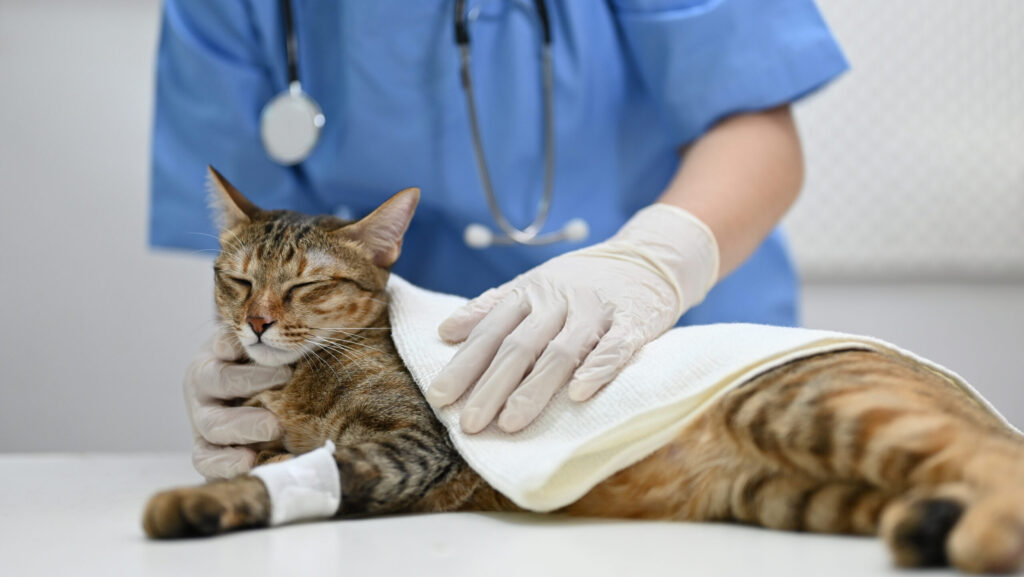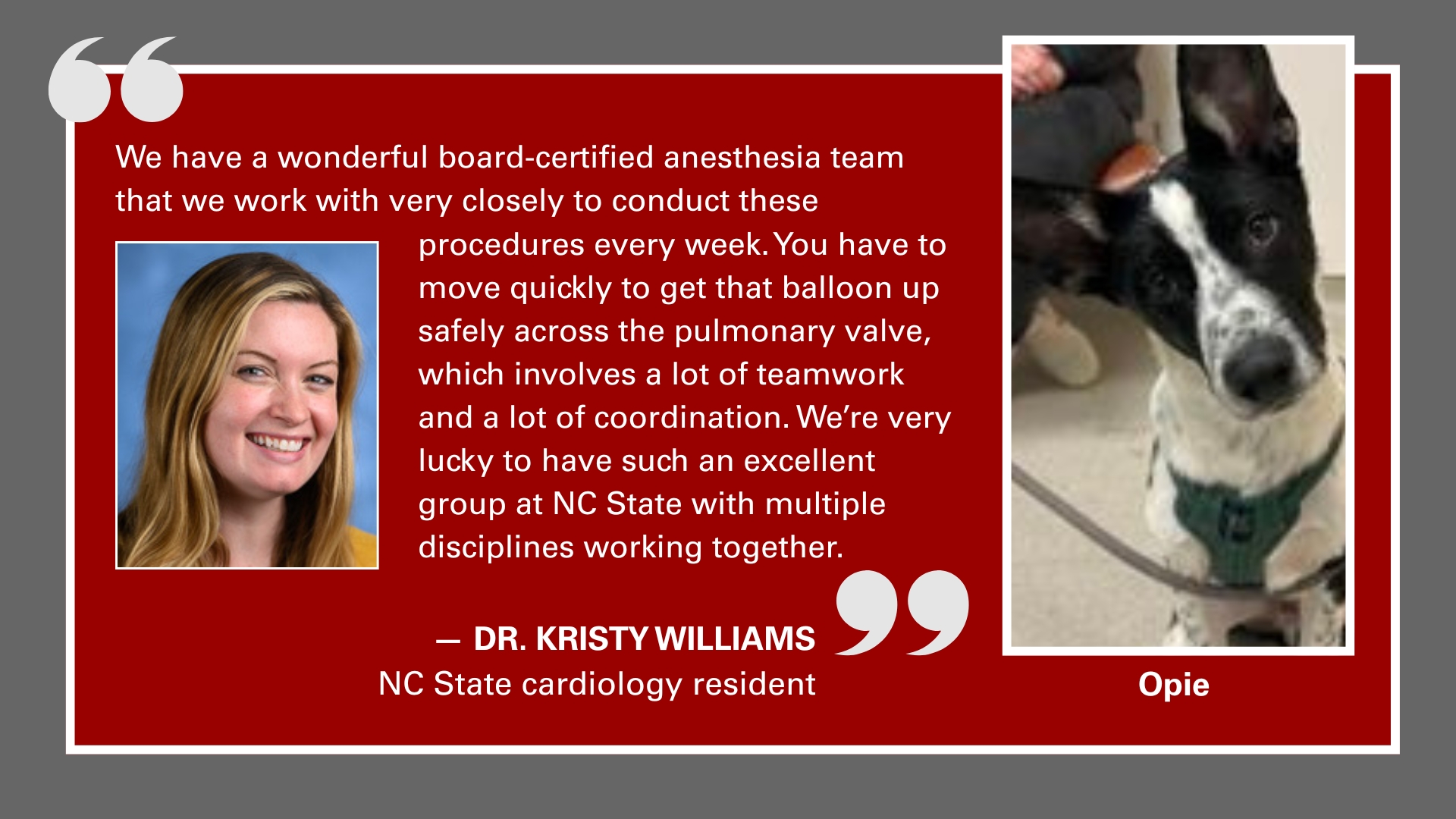Research Roundup May 2025
Science doesn’t stop at the conclusion of a study. Researchers at the NC State College of Veterinary Medicine revisit and analyze recent discoveries and innovations to ensure the most effective results. Through their thorough work, we are changing the scope of medicine for both animals and humans.

Galvis JA, Satici MY, Sykes AL, O’Hara KC, Rochette L, Roberts D, Machado G.
African swine fever virus is highly contagious and often fatal, making the risk of the disease spreading into currently uninfected countries, like the United States, a major animal welfare and economic concern. Understanding what our current resources are is necessary to help officials be prepared with a strategic response to an outbreak. A team of researchers, including members of the NC State Department of Population Health and Pathobiology, developed a model to estimate the resources needed — such as number of samples, laboratory capacity and processing times — for effectively detecting and controlling an African swine fever virus (ASFV) outbreak in a densely populated swine region in the United States. In the model’s severe outbreak scenario, up to 3,115 sample collectors and tens of thousands of daily samples could be needed. However, findings suggest that strategies such as using oral fluid instead of blood samples, implementing downtime after visiting infected farms and pooling samples for testing could greatly reduce these demands and ease the workload of testing laboratories. Overall, the findings highlight the importance of efficient planning and resource allocation to ensure rapid detection and control of African Swine Fever Virus, should an outbreak ever occur in the United States.
The study was published in Preventive Veterinary Medicine and can be read here.
Developing a Ferret Immune Response Resource Guide to Enhance the Study of Human Respiratory Disease
Walsh ES, Yang K, Tollison TS, Seenu S, Adams N, Zeitoun G, Sideri I, Folch G, Brochu HN, Chou H, Kossida S, York IA, Peng X.
We know ferrets are an important animal model for human respiratory diseases, but it has not been fully understood how their B cells and T cells, which are key parts of the immune system, recognize and fight off infections. A team of international researchers, including members of the NC State Department of Molecular Biomedical Sciences, used advanced gene sequencing technology to analyze more than 120,000 immune cells from ferret spleen and lymph node tissues, allowing the researchers to identify and map the important parts of the genes that make up B cell and T cell receptors. The team then used this information to create a reference and resource guide to help future analyses of the ferret immune system. The results of the project will help researchers better understand how ferrets respond to diseases and vaccines, making them even more useful as models for human health research.
The study was published in the Journal of Virology and can be found here.

Evaluating the Effectiveness of Recently Approved Canine Osteoarthritis Treatment
Monteiro BP, Simon A, Knesl O, Mandello K, Nederveld S, Olby NJ, Innes JF, Lascelles BDX.
Osteoarthritis is common in dogs, affecting their mobility and quality of life. Nonsteroidal anti-inflammatory drugs are a common treatment to help with pain but can cause significant side effects, leading to the development of new options such as the antibody bedinvetmab (brand name Librela™). This treatment is a monthly injectable that targets nerve growth factor, a protein that plays a key role in osteoarthritis pain. The treatment was approved in the European Union in 2020 after rigorous approval processes. However, medical researchers still conduct post-approval studies to monitor the overall success of new treatments and whether any new side effects appear over time. This is why a collaborative group of researchers, including members of NC State’s Department of Clinical Sciences, other pain specialists and industry partners from global animal health company Zoetis reviewed global safety data for bedinvetmab beginning from when it launched in February 2021 through June 2024. Out of more than 18 million doses given, about 9.5 adverse events were reported per 10,000 doses, with most side effects — such as lack of effect, increased thirst, wobbly movement and vomiting — being rare or very rare and seen mostly in older dogs. Overall, the results of the study show that bedinvetmab has a strong safety profile when used in real-world settings.
The study was published in Frontiers in Veterinary Science and can be read here.
Assessing the Experiences of Neurodivergent Care Providers in Specialty Veterinary Medicine
Tucker-Retter EK, Westermeyer HD.
It is incredibly important in the medical workplace to foster a supportive and compassionate environment for both the patient and the health care team. Neurodevelopmental differences like ADHD and autism are often misunderstood and largely under researched in terms of workplace support and accommodations. This includes the field of veterinary medicine. To better understand the experiences and needs of neurodivergent team members, a recent study conducted by members of the NC State Department of Clinical Sciences evaluated the experiences of 215 veterinarians and residents with neurodevelopmental differences through an online survey. They shared the challenges they’ve faced in their veterinary training and careers along with what kinds of support have helped them throughout their education and careers. Most participants had ADHD, which was commonly linked to difficulties with executive functioning tasks like time management, organization and focus. Those with autism were more likely to struggle with social interactions and felt it necessary to “mask” and hide their differences to fit in. This study highlighted unique strengths neurodivergent persons often bring to the profession, such as empathy, creativity and attention to detail. The findings also highlight a strong need for more awareness, acceptance and support for neurodivergent individuals in veterinary medicine.
The study was published in Veterinary Ophthalmology and can be found here.

Assessing the Importance of Proper Client Communication Regarding Adherence to Antimicrobial Treatments
Frey E, Kedrowicz AA, Hedgpeth MW.
Proper use of antibiotics plays an important role in the One Health goal of combating antimicrobial resistance. It is essential for veterinarians to be able to communicate a treatment plan with their clients that meets both the clients’ goals and also follows best practices for the use of antibiotics. However, there can be a lapse in communication if the veterinarian assumes that clients know more about antimicrobial resistance than they actually do. A qualitative study that involved members of the NC State Department of Clinical Sciences aimed to assess veterinary student perception of client knowledge surrounding antibiotics to better understand how to integrate communication on antimicrobial use into the veterinary curriculum. Thirty-three veterinary students across all years were put into focus groups. The results of the analysis showed five common themes that can help guide educators when designing the curriculum to train the next generation of veterinarians to communicate about antibiotics and emphasize to clients the importance of adhering to the prescription to ensure the best outcome for their animals.
The study was published in the Journal of Veterinary Medical Education and can be found here.
Research Connection: Associate Professor Dr. Amit Sharma (Department of Population Health and Pathobiology)
Dr. Amit Sharma’s research dives deep into viral-host interactions to prevent and treat infections. By understanding how viruses work, his team develops vital antivirals and vaccines for emerging threats to both people and pets.
- Categories:


